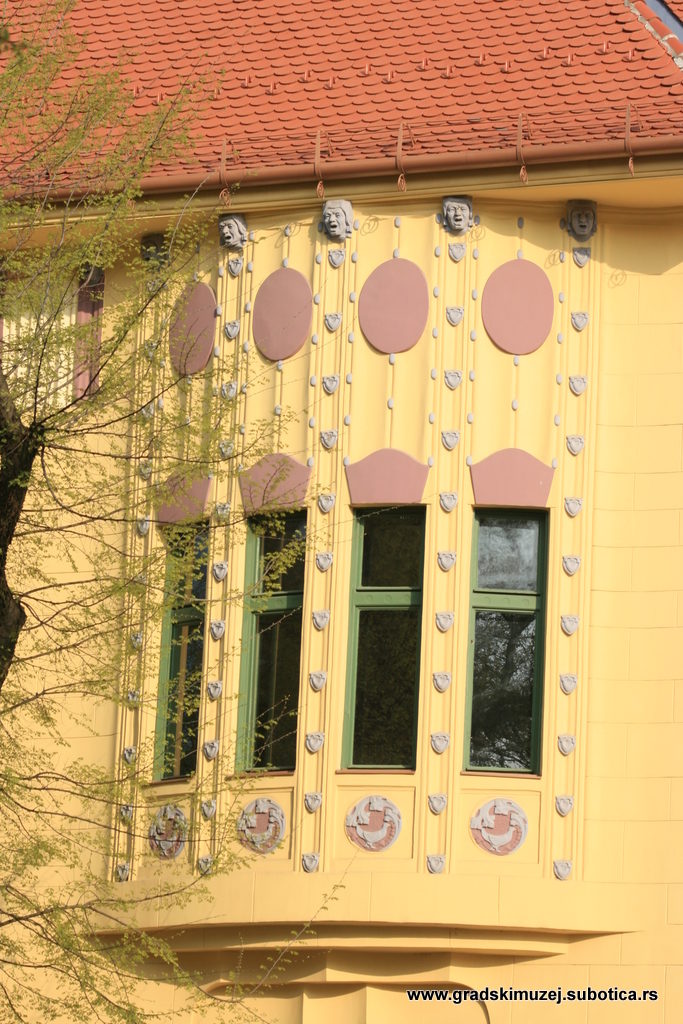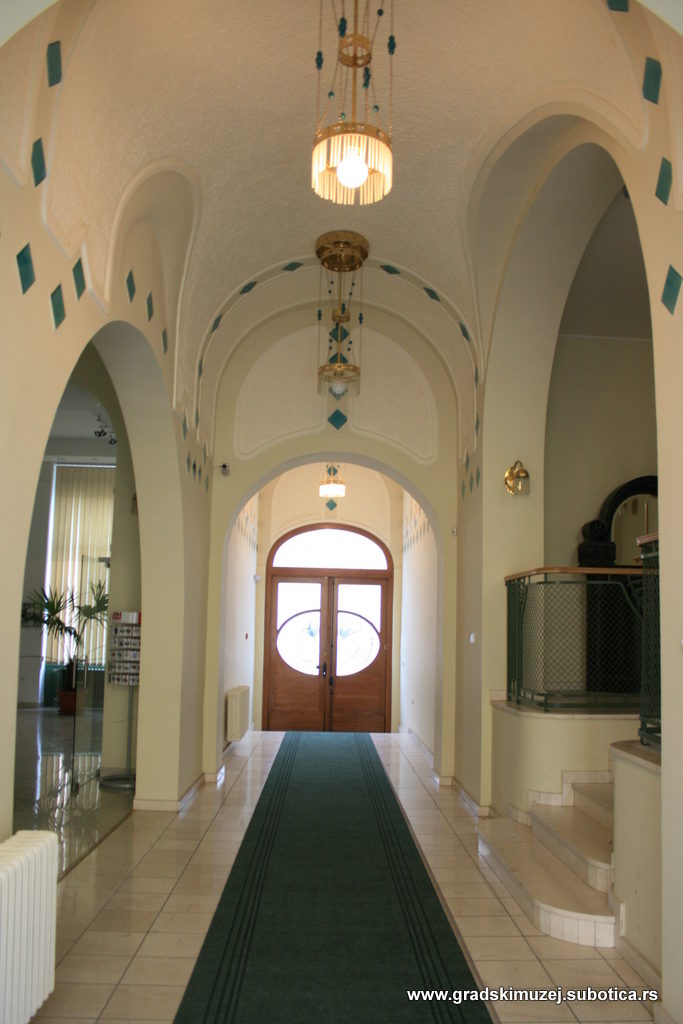
In 2008, according to the decision of the Representative Body of the Municipality of Subotica that founded the Museum, the building of the once prestigious Minerva Press became the new residence of the Municipal Museum of Subotica. After the family palace of architect Ferenc Raichle (1948–1968) and the Town Hall, this is the third home of the institution. 101 years after the construction of this Secession building the Museum is its sixth resident. When renovation began, we paid tribute to former residents with a minor exhibition (Hazatérés – Homecoming) and a publication that appeared in September 2007. We are proud to say that they contributed significantly to the spiritual, intellectual and creative development of the town’s life, and the aim of the present management of the Museum is to follow this tradition.
The building was commissioned by paediatrician Miksa Dömötör (1868–1944), who graduated in Medicine in Budapest in 1894, and started working in Subotica that same year. Besides working at his own surgery, he was also the physician of an insurance firm. He was the first in town to apply a serum as cure for diphtheria, and he also worked a lot on curing trachoma and did X-ray diagnoses. In 1895 he translated and published the book of Emil Adolf von Behring, a professor of Halle University, called The New Anti-Diphtheria Cure. The following year he published his own book under the title On Serums, which was published by the Fischer and Krauss Press in Subotica. In 1904, at the assembly of the Hungarian Science Academy in Budapest, he had a presentation on the operative cure of trachoma. Beside his primary occupation, he also took an active part in the town’s business life. He was Vice-Director of the Favorit Szikvízgyár, a seltzer water factory, between 1906 and 1916; he was member of the management team at the Kőfaragó és Márványipar Rt., a stonework and marble company for a few years, and took part in the founding of the Kereskedők és Iparosok Önsegélyező Szövetkezete, a self-support co-op in 1909. His versatility and wide range of interest is also proven by the fact that he published the first (and probably last) issue of Délmagyarországi Méhészeti Lapok a beekeeping magazine, on 1 July 1906, where we can read his name as chief editor. His marriage to Jolán (1876–?), the daughter of the physician József Klein, in autumn 1899 brought stability to his life. Jolán’s dowry was a three room house at 63 Petőfi Street. They lived there until 1906, when the one-storey Secession apartment house designed by Vágó József (1877–1947) and László ( – ) from Budapest was finished.

On the ground floor of the building designed by the Vágó brothers, to the right of the entrance there were two shops, and behind them a press, which reflects Dömötör’s business interest at the time. The owner’s five-room flat and his surgery were located to the left of the entrance, and upstairs there were two similar apartments to let. All of these had modern interiors: the common rooms were in the central part of the flat, but each family member had also a separate room where others did not disturb. The rooms were arranged in a semi-circle, and opened to the central hall. The windows of the bedroom, the salon, the dining room and the man’s room faced the street, along the wall of the next door house was the toilet, and facing the garden were the two children’s rooms and the hall. The kitchen and the servants’ rooms were in the yard-side wing of the house.

This arrangement made it possible for people to move around the flat undisturbed. Visitors would enter the salon directly from the hall; the bedroom was accessible through the bathroom, while the children’s rooms were completely separate. Even though the rooms adjoined each other, they also had their own entrance from the hall.
When designing Dr. Dömötör’s house, the Vágó brothers were inspired by the Secession architecture of Darmstadt and Vienna. The bird that appears as a decorative detail on each of the Vágó brothers’ buildings can also be found on this house. It is most pronounced on the wrought-iron balcony rails, on which we can see two birds facing each other. Further decorations of the facade include motifs resembling a heart and a feather. The house of Miksa Dömötör is an exceptional mixture of functional and artistic architecture design.

Dr. Dömötör’s activities in Subotica came to an end when he applied and received the position of physician in Kanjiža. Originally Dr. Kuthy, a local doctor aspired to get this post, and just for order’s sake he asked his medical colleagues Dr. Dömötör and Gyula Roxer to run for the position. However, Dömötör took the application very seriously, and to Dr. Kuthy’s biggest surprise, he secured this post to himself. Thus in 1914 Dr. Dömötör left Subotica, by which time he was no longer the owner of the house.
It is still a mystery why Dr. Dömötör sold the house only a year upon its completion. The land register from the mid-1910s lists the Szabadkai Kereskedelmi és Hitelintézet mint Szövetkezet, a trading and loan association, as the owner of the building. Later, in February 1923, according to the bill of sale, this house became the property of Trgovačko-prometno d.d. za Vojvodinu, a trade corporation from Vojvodina, for 375,000 dinars.

Even though the Minerva Press and the Bácsmegyei Napló, which was probably the most significant paper of Subotica, started up separately, their history interwove in the person of Ferenc Fenyves. This great figure of journalism in Subotica was born in 1885 in Nagyszentmiklós. In 1894 he moved to Subotica with his family. At the age of fourteen, Fenyves was editing the Előre school magazine in the Grammar School in Subotica, gaining there his first journalistic experience; Dezső Kosztolányi, Artúr Munk, István Szabó Batancs and Géza Csáth also wrote for this paper. From 1903 he studied law in the Hungarian capital, but even there he could not live without journalism (Budapesti Napló).
The political paper Bácsmegyei Napló was issued in Subotica from 1903. The first years passed with orientation, as journalists and editors often alternated because the owners were politicians and entrepreneurs. This was probably why in the beginning of 1907 the newspaper was closed down. After more than a year’s pause, Ernő Fischer, the owner of the paper at the time, wrote a letter to Mayor Károly Bíró on behalf of the Hungária Press, informing him that from 22 June 1908 the Executive Editor of Bácsmegyei Napló would be Ferenc Fenyves.

Although there was no uniformed political view within the editorial office, we can nonetheless say that the paper was democratically oriented and advocated social justice and tolerance. Beside daily topics and news (crime and judicial), literary supplements and Christmas extra editions were also published. When the First World War broke out, the paper employed special reporters, and from May 1915 two numbers were issued per day (at 6 a.m. and 5 p.m.).
After the First World War, during the Kingdom of Yugoslavia, the activities of the paper threatened to cease on a number of occasions; moreover, due to strict censorship, most of the pages of the Bácsmegyei Napló were printed blank. None of this could discourage Ferenc Fenyves, who managed to increase circulation numbers from the initial 1,500–2,000 to 18,000 between the two World Wars, which made him the editor of the most successful Yugoslavian paper in Hungarian language.
Apart from raising the professional standard of the paper, Fenyves also took an active role in its financial management. From 1910 he was the sole owner, and from the middle of 1913 his elder brother Lajos Fenyves became his partner. At the end of September 1914, he established the Fenyves and Co. press with Aladár Hirt, and in June 1915 the paper and the press were joined within a Public Limited Company called Minerva Press and Publisher, with a start-up capital of 35,000 crowns.
On 1 June 1925 the 1 million dinar bill of sale was signed transferring the ownership rights of Miksa Dömötör’s former house from Trgovačko-prometno d.d. za Vojvodinu to Minerva Press and Publisher Ltd. The house at 3 Jovan Zmaj Square became the head office of the company and the residence of the families of the Fenyves brothers. This is where Ferenc Fenyves lived with his wife Erzsébet (born Baruch) and his children, and Lajos Fenyves with his wife Klára (born Geréb), an academic graphic artist, and their children. With a 800,000 dinar bill of sale, in November 1932 the house became the property of Erzsébet Fenyves.
From 1929, by the order of the current government, the newspaper’s name was shortened to Napló and was edited by Ferenc Fenyves until 18 October 1935. Even after his death his name was left in the headers until 17 April 1941, the appearance of the last issue. The new local government had ruled the further publishing of the paper unnecessary.
This was the beginning of the Second World War, which was the darkest period for the residents of this house. In spring 1944 they were relocated to the Subotica ghetto, and on 21 April 1944 a note was added in the land register saying the owner of the house is a Jewish woman. This must have been the verdict against them. Neither Erzsébet Fenyves, nor Klára Geréb survived Auschwitz, and contemporaries say that Lajos Fenyves died in Subotica shortly after returning from the lager. To make matters worse the communist government nationalized the house on 18 June 1946 making the Fenyves children homeless. On the very same day a warrant was issued making the Minerva Press owner of the house, which remained so for several decades, until recent times.
Mirko Grlica
